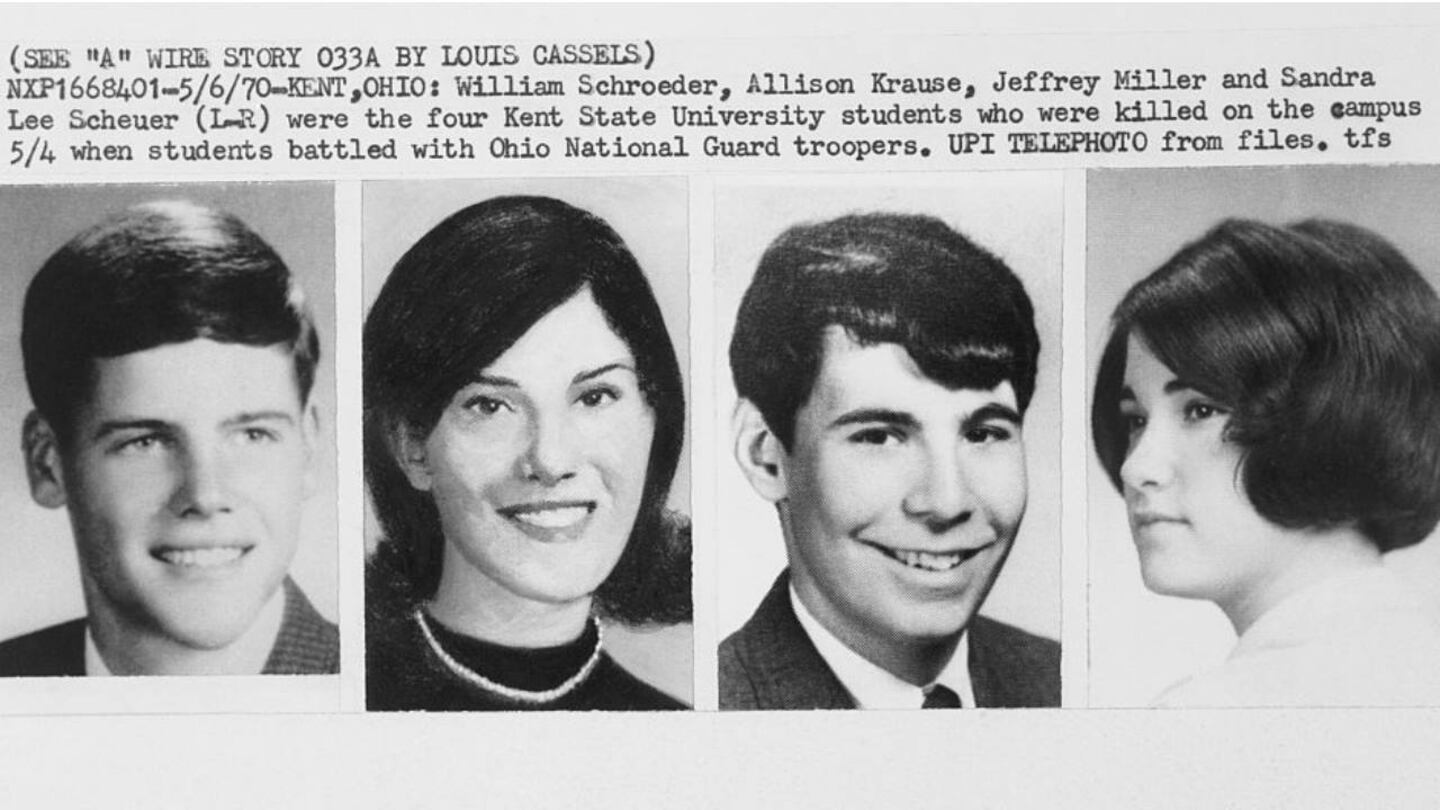KENT, Ohio — Tin soldiers and Nixon’s coming …
Those words, following Neil Young’s mournful guitar lick that opens the 1970 Crosby, Stills, Nash & Young song, “Ohio,” documented a watershed moment in U.S. history.
“Four dead in Ohio,” marked its 54th anniversary on Saturday.
On May 4, 1970, in just 13 seconds, four students at Kent State University -- Allison Krause, Jeffrey Miller, Sandra Scheuer, and William Schroeder -- were fatally shot when National Guardsmen opened fire. Nine others were wounded on the small campus. Fifty-four years later, in the Ohio town of Kent, the university held a series of events to mark the shooting, as it does every year.
In September 1970, five months after the shootings, the President’s Commission on Campus Unrest delivered to Richard M. Nixon a “Letter To The American People,” according to The Associated Press.
“This crisis has roots in divisions of American society as deep as any since the Civil War,” the panel wrote. “The divisions are reflected in violent acts and harsh rhetoric and in the enmity of those Americans who see themselves as occupying opposing camps.”
That sounds eerily similar to the current protests by college students who have taken sides in the Israel-Hamas war. The only difference -- so far -- is that there have not been any shootings, or a bombing like the one in August 1970 at the University of Wisconsin that killed one person and caused $6 million in damage.
Robert Cohen, a professor of history and social studies at New York University, told the AP that comparing the current nationwide campus protests to the anti-Vietnam War movement of the late 1960s would be an overreaction.
“I would say that this is the biggest, in the United States, in the 21st century,” Cohen told the news organization. “But you could say, `Well, that’s like being the tallest building in Wichita, Kansas.’”
Temple University historian Ralph Young disagreed with Cohen.
“I think they do compare in scale and impact,” Young told the AP. Just as in the 1960s and ‘70s, he said, the current crackdowns “only get more and more people angry and I think it’ll just magnify the protests, and spread them further into other campuses.”
Here are some things to know about the Kent State shootings:
Context
On April 30, 1970, President Richard Nixon gave a nationally televised address and said “attacks are being launched this week to clean out major sanctuaries on the Cambodian-Vietnam border.”
The announcement came 10 days after Nixon announced the withdrawal of 150,000 troops from Vietnam. The decision sparked unrest at college campuses nationally, according to Smithsonian Magazine, including Kent State, which had a small, militant chapter of Students for a Democratic Society. In Kent, there was a violent confrontation between protesters and local police on Friday, May 1. Bonfires were built downtown, bottles were thrown at police cars, and rocks were thrown through glass windows.
13 seconds
Students nationwide had been protesting the Vietnam War as early as 1965, and tensions continued to simmer. Those tensions boiled over on Monday, May 4, 1970. Around noon, the National Guard broke up a rally on the Commons, throwing tear gas to disperse a crowd of about 1,000 people. Students threw rocks and were chased by the Guardsmen, who followed the students to an area called Blanket Hill. And then the shooting began. Guardsmen fired 67 shots from M-1 rifles at the students, according to Smithsonian Magazine.
An Ohio National Guardsman who was at Kent State on the day of the shooting told the Akron Beacon Journal this week that the scene was “a horrendous sight, and anyone who witnessed it, whether actively involved or a bystander, would not ever forget.”
The Guardsman, who requested anonymity to protect his identity, told the newspaper that when troops reached the crest of the hill. “some looked back through their gas masks, which may have caused the protesters to appear closer than they actually were.”
At this point, more troops turned, took a firing position and raised their rifles,” he told the Beacon Journal. “I distinctly heard one shot fired; then all hell broke loose when 28 men fired a total of 67 shots over a period of 13 seconds.
“Most students did not believe our weapons were loaded, and those that did thought our ammunition was simply blanks, even though they were repeatedly and loudly told otherwise,” he told the newspaper. “If the students had only listened to what they were told, it may have tempered their actions.”
The victims
Allison Krause: Born in Cleveland, Alison Beth Krause was 19 when she died. he graduated from Churchill Area High School in Pittsburgh. According to her obituary, several days before her death, she was noted as having said “flowers are better than bullets.” Krause was walking with her boyfriend to a class when the shooting began, Newsweek reported in 1970. She was hit by a bullet that entered her upper left arm and then shattered in her chest, causing massive internal injuries. “She had just stopped to look around and see what was happening,” a fellow student told Newsweek. Her father, Arthur Krause, blamed Nixon for her death. “Is dissent a crime?” he told the magazine. “Is this such a reason for killing her? Have we come to such a state in this country that a young girl has to be shot because she disagrees deeply with the actions of her government?”
Jeffrey Miller: Jeffrey Glenn Miller, 20, grew up in Plainview, New York, and loved “the Mets, music, math and motorcycles,” his mother, Elaine Holstein, told Steve North of WLIR radio in a May 1980 interview. “He had posters up all over his room: Jimi Hendrix, The Grateful Dead, Jefferson Airplane. He was very insistent that I share in what he loved so much. Miller, a junior at Kent State who objected to the Vietnam War, went to join the protest, The New Yorker reported. He was shot in the mouth.
William Schroeder: As a member of the Cub Scouts, William Knox Schroeder earned the rank of Eagle by the age of 13, The Daily Record reported. He was 19 in the spring of 1970 after transferring to Kent State from the Colorado School of Mines the previous fall, according to the newspaper. Schroeder, an ROTC student, did not support the war in Southeast Asia, The New Yorker reported. “He didn’t like Vietnam and Cambodia but if he had to go to Vietnam,” his roommate said, “he would have gone.” Schroeder was walking to class when he was shot in the back, according to the magazine.
Sandra Lee Scheuer: Known as Sandy and from Youngstown, Scheuer was 20 and an honors student in the spring of 1970. She had been training to become a speech therapist, and spent time in the department’s clinic helping students overcome speech impediments, the Akron Beacon Journal reported. Shot in the neck, she bled to death, The New Yorker reported.
The photograph
Photographer John Filo won a Pulitzer Prize for his dramatic picture of 14-year-old Mary Ann Vecchio, screaming over the body of Jeffrey Miller after the shooting.
“Well, I was the only idiot standing on the sidewalk,” Filo told CBS News correspondent Maurice DuBois in 2017. “I dropped the camera when I realized it was live ammunition.”
Filo saw Miller on the ground -- “The volume of blood that was flowing from his body was as if someone tipped over a bucket,” he said -- and moved to get a better angle, when he saw Vecchio crouching over the young student’s body.
“As I moved closer she just sort of let out with a scream,” Filo said. “I was a frame and a half from the end of the (camera) roll.”
But he got the photograph.
The aftermath
The shootings ignited a nationwide student strike, which led to the closing of hundreds of colleges and universities. The Scranton Commission, in October 1970 found that “The indiscriminate firing of rifles into a crowd of students and the deaths that followed were unnecessary, unwarranted, and inexcusable,” The Cleveland Plain Dealer reported. A federal judge dismissed a criminal case against eight Guardsmen, and a civil trial was settled out of court in 1979, with $675,000 awarded to the families of the students who were killed or wounded, the newspaper reported.
“During the days that followed, all students and National Guardsmen vacated the campus,” the former Guardsman told the Beacon Journal. “With the hostility, aggressive behavior and stressful altercations we dealt with during those frantic days, I will remember them as some of the most anxious experiences of my life.
“Like many other Guardsmen, it was not my choice to be on the Kent State campus “mixing it up” with protesters, but those were our orders and they were not optional.”
Remembrance
For years, Kent State tried to downplay the event, but finally embraced it, according to the Plain Dealer. The 17 acres where the shootings occurred was designated as a National Historic Landmark on Dec. 23, 2016.
“In retrospect, the tragedy of May 4, 1970, should not have occurred,” the National Guard said in a statement after the case was over. “Hindsight suggests that another method would have resolved the confrontation. Better ways must be found to deal with such a confrontation.”
Dean Kahler, who was paralyzed at Kent State when a bullet went through his lung and damaged his spine, wonders if campus administrators today are making the same mistakes that colleges made 54 years ago.
“I question whether college administrators and trustees of colleges have learned any lessons from the ‘70s,” Kahler told the AP in an interview at his home outside Canton, Ohio. “I think they’re being a little heavy-handed, a little over the top.”
© 2024 Cox Media Group




























